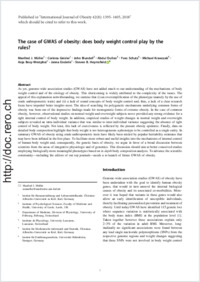The case of GWAS of obesity: does body weight control play by the rules?
- Müller, Manfred J. Institut für Humanernährung und Lebensmittelkunde, Christian-Albrechts-Universität zu Kiel, Germany
- Geisler, Corinna Institut für Humanernährung und Lebensmittelkunde, Christian-Albrechts-Universität zu Kiel, Germany
- Blundell, John Institute of Psychological Sciences, Faculty of Medicine and Health, University of Leeds, UK
- Dulloo, Abdul G. Department of Medicine, Division of Physiology, University of Fribourg, Switzerland
- Schutz, Yves Institute de Physiology, University Lausanne, Switzerland
- Krawczak, Michael Institut für Medizinische Informatik und Statistik, Christian-Albrechts-Universität zu Kiel, Germany
- Bosy-Westphal, Anja Institut für Humanernährung und Lebensmittelkunde, Christian-Albrechts-Universität zu Kiel, Germany
- Enderle, Janna Institut für Humanernährung und Lebensmittelkunde, Christian-Albrechts-Universität zu Kiel, Germany
- Heymsfield, Steven B. Institut für Ernährungsmedizin, Universität Hohenheim, Stuttgart, Germany
-
2018
Published in:
- International Journal of Obesity. - 2018, vol. 42, no. 8, p. 1395–1405
English
As yet, genome-wide association studies (GWAS) have not added much to our understanding of the mechanisms of body weight control and of the etiology of obesity. This shortcoming is widely attributed to the complexity of the issues. The appeal of this explanation notwithstanding, we surmise that (i) an oversimplification of the phenotype (namely by the use of crude anthropometric traits) and (ii) a lack of sound concepts of body weight control and, thus, a lack of a clear research focus have impeded better insights most. The idea of searching for polygenetic mechanisms underlying common forms of obesity was born out of the impressive findings made for monogenetic forms of extreme obesity. In the case of common obesity, however, observational studies on normal weight and overweight subjects never provided any strong evidence for a tight internal control of body weight. In addition, empirical studies of weight changes in normal weight and overweight subjects revealed an intra- individual variance that was similar to inter-individual variance suggesting the absence of tight control of body weight. Not least, this lack of coerciveness is reflected by the present obesity epidemic. Finally, data on detailed body composition highlight that body weight is too heterogeneous a phenotype to be controlled as a single entity. In summary GWAS of obesity using crude anthropometric traits have likely been misled by popular heritability estimates that may have been inflated in the first place. To facilitate more robust and useful insights into the mechanisms of internal control of human body weight and, consequently, the genetic basis of obesity, we argue in favor of a broad discussion between scientists from the areas of integrative physiologic and of genomics. This discussion should aim at better conceived studies employing biologically more meaningful phenotypes based on in depth body composition analysis. To advance the scientific community—including the editors of our top journals—needs a re-launch of future GWAS of obesity.
- Faculty
- Faculté des sciences et de médecine
- Department
- Département de Médecine
- Language
-
- English
- Classification
- Biological sciences
- License
-
License undefined
- Identifiers
-
- RERO DOC 323437
- DOI 10.1038/s41366-018-0081-6
- Persistent URL
- https://folia.unifr.ch/unifr/documents/307330
Statistics
Document views: 156
File downloads:
- pdf: 287
